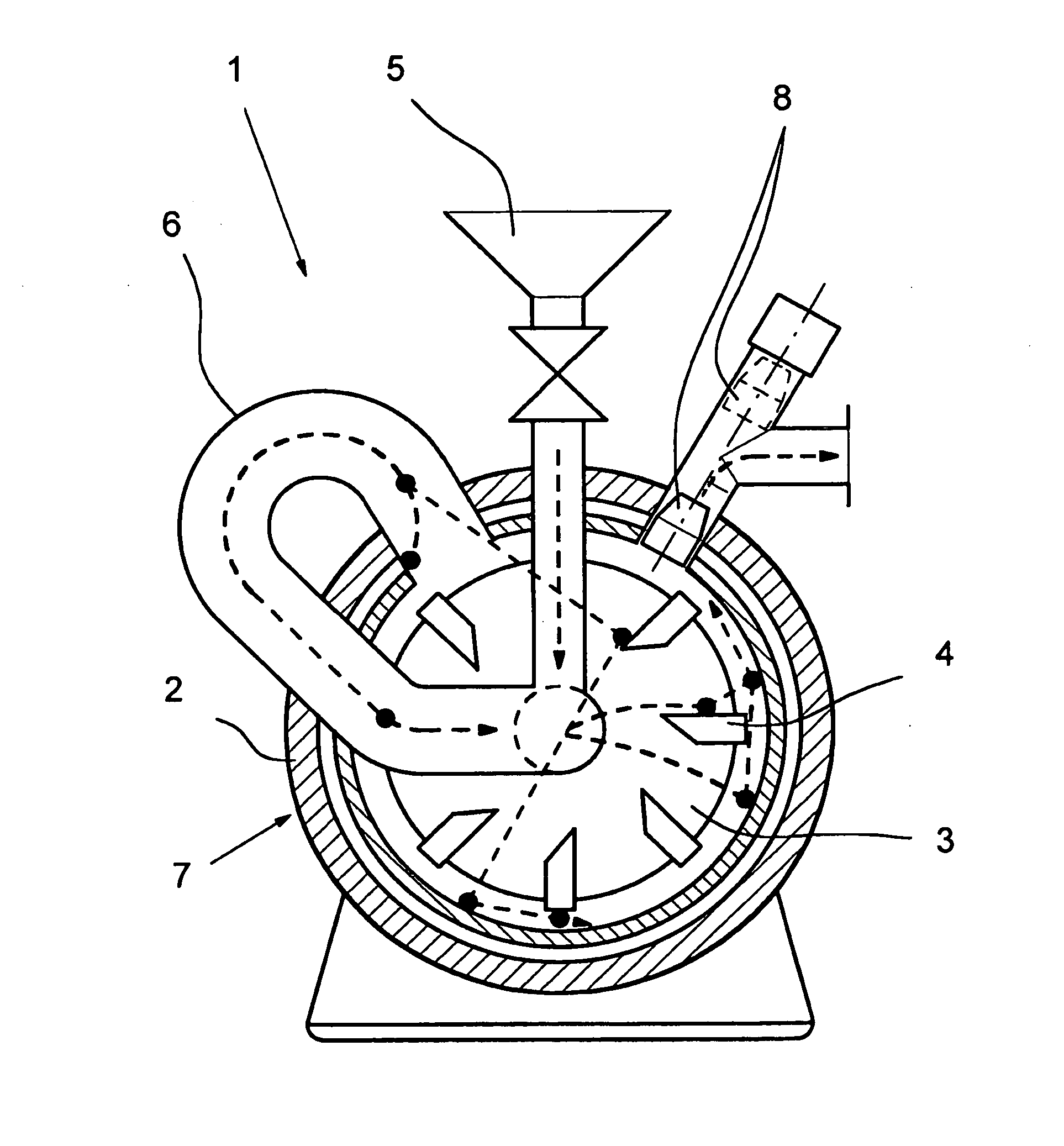Production of nanoparticles, especially nanoparticle composites, from powder agglomerates
a technology of nanoparticles and powder agglomerates, which is applied in the direction of powdery paints, grain treatments, coatings, etc., can solve the problems of insufficient energy transfer from the dispersing assembly to the agglomerates or aggregates, and the problem of large difficulty in the generation of homogeneous particle composites containing few or no agglomerates and/or aggregates,
- Summary
- Abstract
- Description
- Claims
- Application Information
AI Technical Summary
Problems solved by technology
Method used
Image
Examples
example 1a
[0075]LDPE powder is dispersed in a Nara NHS-1 (Nara Hybridization System) stator / rotor device with 30% zinc oxide particles of NanoTec® ZH type at 8000 rpm for 2 minutes. Subsequently 2% by weight of these nanocomposites is used in the production of a PE extrudate, from which films are produced. Subsequent analysis by electron microscopy shows, in comparison to processes of the prior art (i.e., use of pure, uncomminuted powder), a markedly reduced number and size of agglomerates / aggregates. This advantage is apparent in an increase in the transparency of the PE films, with a simultaneous improvement in UV absorption.
example 2a
[0076]In the same way, a polyester powder is dispersed with the aforementioned Nara NHS-1 stator / rotor device with 30% of zinc oxide of the NanoTec® ZH type at 6000 rpm for one minute. Subsequently 2% by weight of these nanocomposites is used in the production of a pigmented powder coating material and coatings are produced therewith. Subsequent analysis by electron microscopy shows, in comparison to processes of the prior art (i.e., use of pure, uncomminuted powder), a significantly reduced number and size of agglomerates / aggregates. This advantage is manifested in an improved UV absorption.
Inventive Production of Composite Particles for Modifying or Enhancing the Scratch Resistance of Coatings
example 1b
[0077]CERA-Wax Ceraflour® 988 is dispersed with the aforementioned Nara NHS-1 stator / rotor device with 50% of Nanodur® aluminum oxide at 6000 rpm for 1 minute. Subsequently 4% by weight of these inventive nanocomposites (identified below as “T-23”) is used in a 100% UV system (solvent-free) based on an aromatic epoxide acrylate.
Formulation:
[0078]
Laromer ® 898657.3 parts by weight DPGDA ®28.7 parts by weight Irgacure ® 5004.0 parts by weightinventive compound T-23 or4.0 parts by weightalternatively Ceraflour ® 988TPGDA6.0 parts by weight
Raw Materials:
[0079]
aromatic epoxy resin Laromer ® LR 8986 / BASFbindertripropylene glycol diacrylate TPGDA / BASFreactive diluentdipropylene glycol diacrylate DPGDA / BASFreactive diluentIrgacure ® 500 / Cibaphotoinitiator
[0080]The binder is weighed out together with the reactive diluents and the photoinitiator, and the components are mixed by stirring with a dissolver for five minutes.
[0081]The inventive compound (T-23) and Ceraflour® 988 are incorporated i...
PUM
| Property | Measurement | Unit |
|---|---|---|
| total energy | aaaaa | aaaaa |
| total energy | aaaaa | aaaaa |
| diameter | aaaaa | aaaaa |
Abstract
Description
Claims
Application Information
 Login to View More
Login to View More - R&D
- Intellectual Property
- Life Sciences
- Materials
- Tech Scout
- Unparalleled Data Quality
- Higher Quality Content
- 60% Fewer Hallucinations
Browse by: Latest US Patents, China's latest patents, Technical Efficacy Thesaurus, Application Domain, Technology Topic, Popular Technical Reports.
© 2025 PatSnap. All rights reserved.Legal|Privacy policy|Modern Slavery Act Transparency Statement|Sitemap|About US| Contact US: help@patsnap.com

